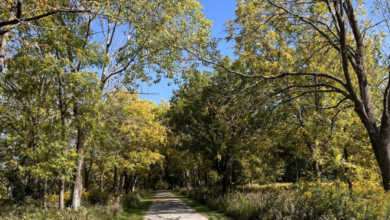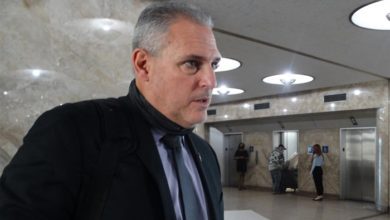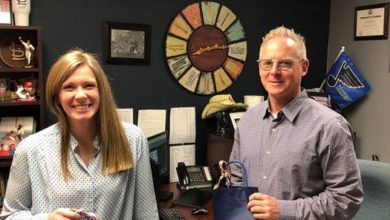Mahomet-Seymour Education Association intends to file grievance with district

The Mahomet-Seymour Education Association leadership said the teacher’s union intends to file a grievance against the Mahomet-Seymour School District, based on hazardous working conditions, after the district voted 4-3 to continue with the hybrid-learning model after the Champaign-Urbana Public Health District recommended that Champaign County Schools return to remote learning in order to help curb the recent spike of COVID-19 cases.
The grievance comes a month after the MSEA filed a demand to bargain when the Mahomet-Seymour board in a 4-3 vote to move from the hybrid model to four-day-a-week in-person learning in January.
In both motions, Merle Giles, Jeremy Henrichs, Lori Larson and Max McComb voted yes, while Meghan Hennesy, Ken Keefe and Colleen Schultz voted no.
Section 14.4 of the 2018 MSEA negotiated contract states, “A bargaining unit member shall not be required to work under unsafe or hazardous conditions or to preform tasks which endanger his/her health, safety, or well being.”
There are three steps to the grievance process:
Step One: : The grievant may present the grievance in writing (within the twenty day time period listed 6.1) to the supervisor immediately involved who will arrange for a meeting to take place within four (4) days after receipt of the grievance. The grievant and the immediately involved supervisor shall be present for the meeting. The supervisor shall provide a written answer to the grievant within two (2) days after the meeting. The answer shall include the reasons for the decision. The purpose of this step is try to resolve the grievance
Step Two: If the grievance is not resolved at Step One, then the grievant shall refer the grievance to the Superintendent or his official designee within six (6) days after receipt of the Step One answer or within eight (8) days after the Step One meeting, whichever is the latter. The Superintendent shall arrange for a meeting with the grievant to take place within five (5) days of his receipt of the appeal. Each party shall have the right to include in its representation such witnesses as it deems necessary to develop facts pertinent to the grievance. Upon conclusion of the hearing the Superintendent shall have three (3) days in which to provide a written decision with reasons to the grievant. The purpose of this step is to try resolve the grievance
Step Three: If the Association/grievant is not satisfied with the disposition of the grievance at Step Two, the Association may submit the grievance to final and binding arbitration. The Demand for Arbitration must be filed with the Board within thirty (30) days of the Step Two decision. If the Association and Board cannot agree upon an arbitrator within seven (7) days of the Demand being filed, the Demand shall be submitted to the American Arbitration Association which shall act as the administrator of the proceedings. If a Demand for Arbitration is not filed with the Board within thirty (30) days, then the grievance shall be deemed withdrawn.
One of the first people to speak on the subject at Monday’s board meeting was Mahomet-Seymour Education Association co-president Meg Jones.
She quoted recent communication from Superintendent Lindsey Hall that talked about how the district would continue with hybrid learning until after Thanksgiving break then reassess again.
“Dr. Hall said it was too early to decide what we should do beyond Thanksgiving,” Jones reported. “Specifically, she said, ‘today is not the day to make that determination. This is an evolving situation and much could change between now and next week for the following week. This is how 2020 has been all along, as we have done since beginning of the school year, we will continue to monitor our cases and exposures respond accordingly and move ahead.’”
The MSEA wanted to know where this line of thinking was when Hall supported the decision to return to full day, four-day-a-week instruction in January.
“In the face of the County Health District recommending all remote schooling, you feel you still don’t know enough to decide what to do next week,” Jones said. “How could you possibly have made an informed decision about next semester?”
The MSEA is of the understanding that the district is in a reactive mode as they wait for cases to happen and respond accordingly.
“In other words, we will wait to see if a lot more of our students and staff get sick, and then respond” Jones said. “Unsurprisingly, MSEA does not find this as an acceptable way to approach a pandemic, especially since neither the board, nor even district management face the exposure risks your teacher and the support staff base do.
“The county health board’s recommendation is a proactive response. It recognizes that if you wait for community spread to clearly be happening before you act, you’ve waited too long.”
Mahomet-Seymour’s cases had increased 57-percent in the previous 10 days.
“We teach and expect our students to respect experts, starting with us. It’s a strange and contrary example we set for our kids when in the midst of a crisis, we disregard the very people with the expertise to get us through it.”
The teacher’s union was happy to help the district do whatever needed to be done to go full-remote as soon as possible.
Later on in the meeting, after the board moved three part-time Health EOP positions to full-time and talked about rapid testing through the Illinois Department of Public Health, board member Meghan Hennesy made a motion to follow the CUPHD recommendation and return to remote learning as soon as possible.
While board member Max McComb looked to IASB’s “Coming to Order” for guidance, stating if it’s not on the agenda, then the recommendation is to not take action on the item, board member Colleen Schultz cited Mahomet-Seymour Board policy 2:220, “each board meeting agenda should contain the general subject matter of any item that will be the subject of a final action in a meeting. The board will take final action only on items contained in the posted agenda. Items not on the agenda may still be discussed.”
There was discussion on the fairness of acting on an item without letting the public know about it first: Schultz said that she asked for the action item to be placed on the agenda 7-days before the agenda was published, per Mahomet-Seymour School Board policy. It was stated that board member Ken Keefe did the same.
Hennesy and board member Merle Giles had also asked for COVID-19 to be placed on the agenda for each board meeting in the months prior. Hennesy wanted it as an action item while Giles wanted it as a discussion item.
Giles said that he believes it’s a disservice to the community to vote on items that are not listed for action when the public has not been able to know a vote will be taken.
Hennesy said, though, that COVID-19 needed to be listed as an action item on every meeting agenda due to the ever-changing nature of the situation where the board needs to pivot in order to meet current needs.
She also said that if the board doesn’t want to take action on something they could “just keep it off the agenda.
“Clearly, COVID is the single biggest thing that we have to deal with right now.”
She suggested that the item, which the MSEA asked the board to take action on, was left off the item “perhaps to avoid having to take a vote.”
McComb said that maybe it was necessary to bring an attorney to the meeting each month. Hennesy said that she had asked for that as the district makes decisions on how to best meet IDPH and ISBE guidelines, and the legal ramifications of moving forward outside of those recommendations.
Hennesy echoed the MSEA’s call to follow expert guidance when it comes to what school districts should do during the pandemic.
She said she understands that not everyone will follow those recommendations because “this is the United States, and we live in a free country.”
Board member Lori Larson said that she doesn’t feel like she lives in a free country.
“I don’t feel too free right now,” Larson said.”I have people telling me that I can’t have my kid be at school, but they can go to Target and to Costco, they can go wherever they want, but they can’t go to school where they are entitled to a free and public education.
“So don’t tell me that I live in a free country.”
After the October vote to proceed with school differently in Jan., Hennesy said that the climate had changed, and that the board should reconsider, via vote, how to move the district forward.
“I think we already voted on this in the past,” board member Jeremy Henrichs said. “I don’t know if another vote is necessary. And I’m a little offended that somehow you’re manipulating this to look like we are trying to ignore certain things.”
He said that while Hennesy was asking the district to listen to experts, there “are certainly experts who disagree on this topic.
“There’s disagreement; there’s not unity in agreement on this topic at all.”
He felt like Hennesy was manipulating the motion to make the district look bad.
Henrichs said that he stands where he has in the past: “We’re a school. We’re open. If you want to come to school, come to school. If you don’t want to come to school, stay home. If you have an illness or a health issue, or a condition that puts you at risk, and you shouldn’t be at work, then you shouldn’t be at work. Everybody else makes these choices.”
Part of being an American, Henrichs said, is making an individual choice. He added that everyone has to accept their own level of risk.
He added that teachers could get a note from their doctor saying that they can’t make it.
“What about the other people who are employed in this county that their employers are asking them to come to work?” Henrichs asked. “Do they get a choice to stay home? No, they probably lose their job if they said I’m just not going to come to work, unless I have a valid reason.”
But Keefe, in his board communication, said that Americans have collectively stepped up to do the little things to make sure that the community had what it needed.
“During the first world war, citizens worked together to conserve much needed food for our troops by instituting wheatless Wednesdays and meatless Mondays,” Keefe said. “During world war 2, gender norms were temporarily set aside and women left the home to do their part for the war effort in factories across America.
“In times of serious crisis, Americans have stepped up to do their part, for their nation and for their neighbors. We must recognize what our part is now, during this crisis. We must act, not in fear or defiance, but in duty to our fellow citizens.
“We must act for the care of the older generations who made greater sacrifices for our benefit when history called upon them. It is our duty to sacrifice the convenience of traditional in-person education for the welfare of our nation and our neighbors.
“Now, the reality is that all of these arguments are correct to some degree. We, the board, must consider them, prioritize, and lead our community. I believe that the most prudent, responsible choice for this board is to hear the pleading of our public health experts and switch to remote learning as soon as possible.”
Mahomet-Seymour Nurse Nita Bachman agreed that the district should listen to the experts, but there is a lot to take into consideration, including the mental health of students, when making a decision.
Bachman said that CUPHD had asked districts to return to remote learning because they are overwhelmed by the amount of COVID-19 positive tests and contact tracing.
Bachman added that public health officials have thanked her for what she is doing internally as far as helping with that contact tracing, sometimes completing the task before the public health department can.
“Even though the numbers are rising, I feel like we are in really good shape,” Bachman said.
Keefe added that he is concerned that as the late fall months move on, the district will have troubling staffing the buildings. He had heard, and Superintendent Lindsey Hall confirmed, that principals have had to fill in as substitutes at times because there wasn’t anyone to supervise the students otherwise. The district recently put out a call for subs, too.
Hennesy’s other concern was that local hospitals are getting overwhelmed. While there was disagreeance on how COVID-19 was impacting local health systems, Carle put out a COVID-19 dashboard, including COVID patients out Tuesday.
In communication to the Region 6 community at-large, Charles Dennis, MD, chief medical officer for Carle Health, said, “Carle serves a broader region that extends beyond the county in which each hospital sits. We have an obligation to support the greater region and are calling on each person seeing and hearing this to double down on their prevention efforts today,” Dr. Dennis said.
“Every hospital bed represents a family member, a friend, a neighbor, perhaps even your loved one. This virus is serious and the current trends are alarming,” Robert Healy, MD, Carle’s chief Quality officer said. “The impact of COVID-19 on each of us is very real.”
Hall said that the district has and will try to accommodate every request from families to move their child to remote learning, if the parents decide to go that way.
She added that as the pandemic has unfolded, the district has had to make decisions in the moment with the information that you have at the time.
“When I supported the recommendation to go back to four full days a week, starting in January, second semester, that was based on information that we had at the time. This has been an evolving and changing situation since March 13. And 8 months later, it’s no different, and it’s not going to be any different going forward.
She said that she’d like to have a plan. The decision she made on Friday, to continue with the hybrid model was made with the information she had at the time, she added.
Schultz asked if Hall would reconsider the recommendation for January with the information she now has.
Hall said that she might.
“The analogy I want to use right now is, I don’t want to call a snow day in January now,” she said.
Schultz also asked for Hall to share COVID-19 information with the board consistently. As she tries to reconsile what she hears in the community and what is on the dashboard, the numbers don’t match up.
More specifically, Schultz had been told by a couple teachers that they contracted COVID-19 while at school, but the district is saying that the teachers contracted the virus elsewhere.
Henrichs said that the virus is so widespread in the community that it would be hard to pinpoint where anyone got it from. Schultz retorted, saying that, with the same logic, there is no evidence to say it is not spread at school.
“I don’t have a sense of how the COVID illness is progressing throughout district,” Schultz said. “I feel like the information is disjointed so I don’t get a big view of it. I feel as though it comes in different pieces in different ways.”
The district dashboard shows the in-person positives and exposures daily. Schultz said that she would like non-identifiable information such as school, student or staff.
Bachman and Hall said that many of the cases on the dashboard are positive cases that have been in quarantine due to previous exposures.
Larson felt like Schultz was asking for a lot.
“I’m just staying focused here,” Larson said. “That’s all I can handle. And that’s my strategy. I care about what happens at Mahomet-Seymour, what happens with our teachers and our kids. And I can’t look at the global picture because it’s destructive.”
Schultz said that that’s what she was trying to do, get information for the community.
“I’m asking the district to provide information for us so that we know we are getting it from the source,” Schultz said.
Hall told Schultz that she would be better about sending notifications to board members, and she agreed that the source for information would be the district, particularly Bachman.
McComb said that he felt bullied into taking a vote, and so the board did.





